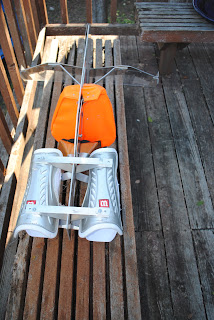(Note: Yesterday I met a gentleman at the ATX Hackerspace who was working on a gardening invention. I don't think it would pass the test of altruism for PIFAM, but it was a great idea. That conversation has inspired me to post this project idea, somewhat out of my intended order.)
Permaculture is a beautiful design methodology. If we apply the idea to a forest, we can ask a question which is difficult to answer, but is objective and scientific, and of the greatest possible benefit to humankind:
How is it possible to extract the greatest possible economic value from a forest without damaging it?
Put another way, how can we extract the greatest possible benefit from a forest, taking into account all externalities:
- Cash flow,
- The animals who live in the forest,
- The plants,
- The fungus,
- The oxygen it produces,
- The beauty it provides,
- The soil stabilization and anti-desertification?
There are probably valuable points I have failed to mention. One can of course accuse me of being a tree-hugging hippy---but I assure you I am the most hard-headed and scientific of dandelion-eaters.
Given a mathematical model that weights each of these partially subjective benefits, can we manage the forest to provide a maximum sustainable yield? And what would that yield be?
How is it possible to extract usable products from a forest without chopping down the trees? For example, is it possible to inoculate logs and snags with an edible fungus? Is it possible to plan an edible crop beneath the trees without destroying the wildlife? Is it possible to collect collect wood from fallen timber sustainably? Is it possible to make paper from pine needles or oak leaves? Can we build a robotic monkey that will collect nuts from a 100-foot high tree? Can we obtain wood more efficiently from pollarding a mature tree than from cutting one down? Can we collect timber without building a road? Can we get people to pay for the privilege of mushroom hunting in a beautiful wood? Can we generate power from tree sap? Can we force a tree to grow in the form of an I-beam so that it need not be sawn to be valuable lumber? Can we put an iron collar on a tree to form the trunk into a beautiful sculpture? Can we build a computer simulation across time of the whole forest? Can we make a game out of trying to utilize the forest? Can we take a truly accurate census of every species present? Can we grow bromeliads in the canopy efficiently? Can we train the limbs to make a walkable path above the ground? Can we hunt the animals in an ethical and efficient way? And how many? Can we generate paper from the forest in situ, without taking the fiber to a paper mill? Can we build a machine that cuts a 2x4 from a tree in a way that it can heal? Can we account for the value of the migration of animals through the space? Can convince the trees to form themselves into an emergency shelter? Can we garden the forest to ensure that something of value can be gathered every week of the year by a visitor sustainably? Can we get the forest to consume our waste products safely? Can we put sewage on it? Can we bury soiled diapers beneath trees? Can the forest become a gymnasium? A running track? A meeting place? A school, a church, a public house? Can the forest become a road, allowing people or cargo to be transported across miles without touching the ground? Can we know precisely when a tree dies and harvest its timber at that time? Is it more efficient to do so? Can we make artificial lairs and dens for animals to improve the density of life? Can we get it to sequester carbon?
Can we make these questions precise and create an experimental plan for methodically answering them?
And, most importantly, does anybody want to lead such a project with my help and support?









